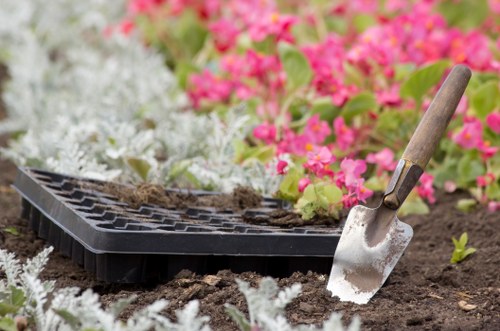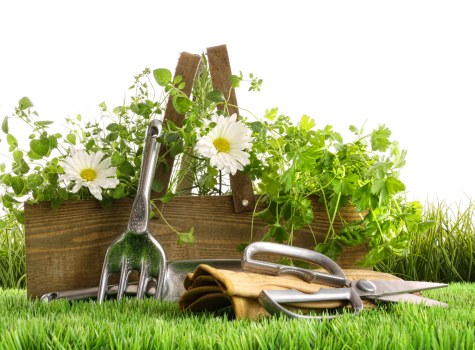Hedge Trimming in Spitalfields: Expert Services for a Pristine Garden

Introduction to Hedge Trimming
Maintaining a beautiful garden in Spitalfields requires regular hedge trimming. Well-trimmed hedges not only enhance the aesthetic appeal of your property but also promote the health and growth of your plants. In this article, we will explore the importance of hedge trimming, the best practices to follow, and why choosing local professionals in Spitalfields can make a significant difference.
Hedge trimming involves carefully cutting and shaping hedges to keep them in good condition. Whether you have a traditional English garden or a modern landscape, regular maintenance ensures that your hedges remain lush and vibrant. Proper trimming also prevents overgrowth, reducing the risk of pests and diseases.
Understanding the specific needs of your hedges is crucial. Different types of hedges, such as boxwood, yew, or privet, require varying techniques and timing for optimal growth. By tailoring the trimming process to your specific plants, you can achieve the best results and maintain a healthy garden.

Benefits of Regular Hedge Trimming
Regular hedge trimming offers numerous benefits that go beyond mere aesthetics. Here are some key advantages:
- Enhanced Curb Appeal: Well-maintained hedges significantly improve the overall look of your property, making it more inviting and attractive.
- Promotes Healthy Growth: Trimming removes dead or diseased branches, encouraging new growth and strengthening the plants.
- Increased Privacy: Dense, well-shaped hedges provide better privacy, creating a secluded and peaceful outdoor space.
- Safety: Preventing overgrown hedges can eliminate hazards such as obstruction of pathways and interference with power lines.
- Environmental Benefits: Healthy hedges contribute to better air quality and provide habitats for local wildlife.
By investing time and resources into regular trimming, you ensure that your hedges remain a valuable asset to your garden and property.

When to Trim Your Hedges
Timing plays a crucial role in effective hedge trimming. The best time to trim varies depending on the type of hedge and the climate in Spitalfields. Generally, the following guidelines can help:
- Spring: Early spring is ideal for shaping hedges before the growing season begins. This allows the plants to recover quickly and develop strong new growth.
- Summer: Light trimming during summer can help maintain the shape and prevent excessive growth. It's also a good time to remove any flowers if you prefer to keep the shape rather than the blooms.
- Autumn: Late autumn trims remove any last-year's growth and prepare the hedges for the winter months.
- Avoiding Winter: It’s generally best to avoid heavy trimming in late fall or early winter, as it can leave the hedges vulnerable to frost damage.
Consulting with a local hedge trimming expert in Spitalfields can provide you with tailored advice based on your specific garden and hedge types.

Choosing the Right Tools for Hedge Trimming
Using the appropriate tools is essential for effective and safe hedge trimming. Here are some common tools used by professionals:
- Hand Shears: Ideal for small hedges and detailed shaping. They provide precision and control.
- Electric Hedge Trimmers: Suitable for medium-sized hedges, offering a balance between power and maneuverability.
- Gas-Powered Trimmers: Best for large or thick hedges, as they provide the necessary power to handle tough foliage.
- Loppers: Useful for cutting thick branches that are beyond the capacity of standard hedge trimmers.
- Safety Gear: Don’t forget to use gloves, safety glasses, and sturdy footwear to protect yourself while trimming.
Investing in high-quality tools ensures that the trimming process is efficient and minimizes the risk of damaging your hedges.

Professional Hedge Trimming Services in Spitalfields
While DIY hedge trimming can be rewarding, hiring professional services in Spitalfields offers several advantages:
- Expertise: Professionals have the knowledge and experience to handle different types of hedges and identify any potential issues.
- Efficiency: Trained gardeners can complete the trimming process quickly and effectively, saving you time and effort.
- Quality Results: Professionals ensure that your hedges are trimmed to perfection, enhancing the overall appearance of your garden.
- Safety: Handling heavy tools and high hedges can be risky. Professionals are equipped to manage these safely.
- Ongoing Maintenance: Many services offer regular maintenance packages, ensuring your hedges remain in top condition year-round.
By choosing a reputable hedge trimming service in Spitalfields, you can enjoy a beautifully maintained garden without the hassle.
Steps Involved in Hedge Trimming
Effective hedge trimming involves several key steps to ensure the health and appearance of your hedges:
- Assessment: Examine the current state of the hedge to identify areas that need trimming and any potential issues such as pests or diseases.
- Planning: Decide on the desired shape and height of the hedge. Planning helps in achieving a uniform and aesthetically pleasing appearance.
- Preparation: Gather all necessary tools and safety equipment. Ensure your tools are sharp and in good working condition.
- Trimming: Start trimming from the bottom, working your way up. Make clean cuts to promote healthy growth.
- Shaping: Shape the hedge according to your plan. Whether you prefer a formal or natural look, consistency is key.
- Cleanup: Remove all trimmings and debris from the garden to prevent the spread of pests and diseases.
- Maintenance: Schedule regular trims to maintain the shape and health of your hedges.
Common Mistakes to Avoid
Even with the best intentions, certain mistakes can hinder the effectiveness of hedge trimming:
- Overtrimming: Cutting too much can stress the plants and inhibit their growth. It's better to trim gradually over time.
- Improper Tools: Using dull or inappropriate tools can damage the hedges and lead to poor results.
- Ignoring Plant Health: Failing to address pests, diseases, or signs of distress can worsen the condition of your hedges.
- Wrong Timing: Trimming at the wrong time of year can disrupt the natural growth cycle of the plants.
- Lack of Consistency: Irregular trimming can result in uneven growth and an unkempt appearance.
Avoiding these common pitfalls ensures that your hedge trimming efforts are successful and sustainable.
Eco-Friendly Trimming Practices
Embracing eco-friendly practices in hedge trimming not only benefits the environment but also promotes healthier plants:
- Using Sustainable Tools: Opt for electric or manual tools over gas-powered ones to reduce your carbon footprint.
- Composting Trimmings: Instead of disposing of hedge clippings, compost them to enrich your soil naturally.
- Water Conservation: Trim during times of low moisture to minimize stress on the plants and conserve water.
- Biodegradable Products: Use eco-friendly fertilizers and treatments to maintain plant health without harmful chemicals.
- Minimizing Waste: Plan your trimming to reduce excess waste and ensure that only necessary parts are removed.
Incorporating these practices contributes to a more sustainable and environmentally responsible garden.
Seasonal Considerations for Hedge Trimming
Understanding the seasonal changes can help you plan your hedge trimming schedule effectively:
- Spring: Focus on shaping and removing any winter damage. This is also the time to fertilize your hedges.
- Summer: Perform light trims to maintain shape and control growth. Ensure adequate watering during dry spells.
- Autumn: Prepare your hedges for winter by removing any debris and conducting a final trim.
- Winter: Avoid heavy trimming; however, you can perform minor maintenance if necessary.
Adapting your trimming practices to the seasons ensures that your hedges remain healthy and resilient throughout the year.
Tools and Equipment Maintenance
Keeping your hedge trimming tools in excellent condition is vital for effective maintenance:
- Regular Cleaning: After each use, clean your tools to remove sap, dirt, and debris that can cause rust and damage.
- Sharpening Blades: Sharp blades make cleaner cuts, reducing the risk of plant damage and promoting faster healing.
- Proper Storage: Store your tools in a dry, sheltered place to prevent corrosion and wear.
- Inspection: Regularly check for any signs of damage or wear and replace parts as necessary.
- Lubrication: Keep moving parts well-lubricated to ensure smooth operation and prolong tool lifespan.
Maintaining your tools not only ensures safety but also enhances the quality of your hedge trimming.
Hiring the Right Hedge Trimming Service
When selecting a hedge trimming service in Spitalfields, consider the following factors:
- Experience: Look for services with a proven track record and expertise in handling various hedge types.
- Reputation: Check reviews and testimonials to gauge the quality of their work and customer satisfaction.
- Licensing and Insurance: Ensure that the service is properly licensed and insured to protect against any potential liabilities.
- Pricing: Compare quotes from different providers to find a service that offers good value for money.
- Customer Service: Choose a company that communicates clearly, is responsive to your needs, and provides personalized solutions.
Taking the time to research and select the right service ensures that your hedge trimming needs are met professionally and efficiently.
Cost of Hedge Trimming in Spitalfields
The cost of hedge trimming can vary based on several factors, including the size of the hedges, the complexity of the job, and the specific service provider. On average, you can expect to pay:
- Small Hedges: £50 - £100 per session
- Medium Hedges: £100 - £200 per session
- Large Hedges: £200 - £400 per session
- Additional Services: Fertilizing, pest control, and ongoing maintenance may incur extra costs.
It's advisable to obtain multiple quotes and discuss your specific requirements to get an accurate estimate. Investing in quality trimming services ensures long-term benefits for your garden.
DIY Hedge Trimming Tips
If you prefer to trim your hedges yourself, here are some tips to achieve professional-looking results:
- Plan Ahead: Decide on the shape and size of your hedges before you start trimming.
- Use the Right Tools: Ensure your tools are sharp and suitable for the size of your hedges.
- Trim Gradually: Avoid cutting too much at once. Trim in stages to maintain control over the shape.
- Maintain Consistency: Keep both sides of the hedge even to achieve a balanced appearance.
- Clean Up: Remove all clippings and debris to prevent the spread of pests and diseases.
- Safety First: Wear protective gear and be cautious when handling tools.
With careful planning and the right approach, DIY hedge trimming can be a rewarding activity that enhances your garden’s beauty.
Environmental Impact of Hedge Trimming
Hedge trimming, when done responsibly, can have positive environmental impacts:
- Promotes Biodiversity: Healthy hedges provide habitats for birds, insects, and other wildlife.
- Carbon Sequestration: Well-maintained hedges absorb carbon dioxide, contributing to the reduction of greenhouse gases.
- Soil Health: Trimming helps in maintaining soil structure and preventing erosion.
- Water Management: Properly trimmed hedges can improve water drainage and reduce runoff.
- Air Quality: Lush hedges filter pollutants, enhancing the air quality around your property.
By adopting sustainable trimming practices, you contribute positively to the environment while enjoying the aesthetic benefits of your garden.
Innovative Hedge Trimming Techniques
Advancements in hedge trimming techniques have made the process more efficient and effective:
- Telecentric Cutting: This method ensures uniform cutting angles, promoting even growth.
- Japanese Shearing: A traditional technique that involves meticulous shaping for a natural look.
- Electric Hedge Trimmers with Adjustable Handles: These provide better ergonomics, reducing strain during prolonged use.
- Automated Trimming Systems: Robotic hedge trimmers are emerging as a convenient option for maintaining large hedges.
- Integrated Pest Management: Combining trimming with pest control measures to maintain overall plant health.
Staying informed about these innovative techniques can help you achieve superior results in your hedge trimming endeavors.
Seasonal Challenges in Hedge Trimming
Each season presents unique challenges for hedge trimming that require specific strategies:
- Spring Thaw: Wet conditions can make trimming slippery and increase the risk of injury. Ensure your tools are dry and handle them with care.
- Summer Heat: High temperatures can stress plants. Trim during cooler parts of the day and ensure adequate watering afterward.
- Autumn Fallen Leaves: Removing fallen leaves before trimming prevents them from getting tangled in your tools and affecting the trimming process.
- Winter Frost: Extremely cold weather can make plants brittle. Avoid trimming when frost is present to prevent damage.
Addressing these seasonal challenges ensures that your hedge trimming efforts are effective and your hedges remain healthy throughout the year.
Legal Considerations in Hedge Trimming
When trimming hedges in Spitalfields, it’s important to be aware of any local regulations or property boundary laws:
- Property Boundaries: Ensure that you have the right to trim the hedge, especially if it borders a neighbor’s property.
- Height Restrictions: Some areas have restrictions on how high hedges can be trimmed, particularly near roads or public spaces.
- Protected Species: If your hedge contains protected plant species, additional regulations may apply.
- Complaints and Disputes: Avoid trimming too aggressively to prevent disputes with neighbors or authorities.
Adhering to these legal considerations helps prevent potential conflicts and ensures respectful and responsible garden maintenance.
Conclusion
Hedge trimming in Spitalfields is more than just a routine garden task; it’s an essential practice that enhances the beauty, health, and functionality of your outdoor space. Whether you choose to undertake the task yourself or hire professional services, understanding the best practices and considerations ensures that your hedges remain a stunning feature of your garden.
Regular trimming, the right tools, and a thoughtful approach to seasonal changes and environmental impact all contribute to a thriving garden. By investing in quality hedge trimming, you not only improve your property’s appearance but also contribute to a healthier and more sustainable environment.
Contact us today to book your hedge trimming service in Spitalfields and transform your garden into a picturesque haven.